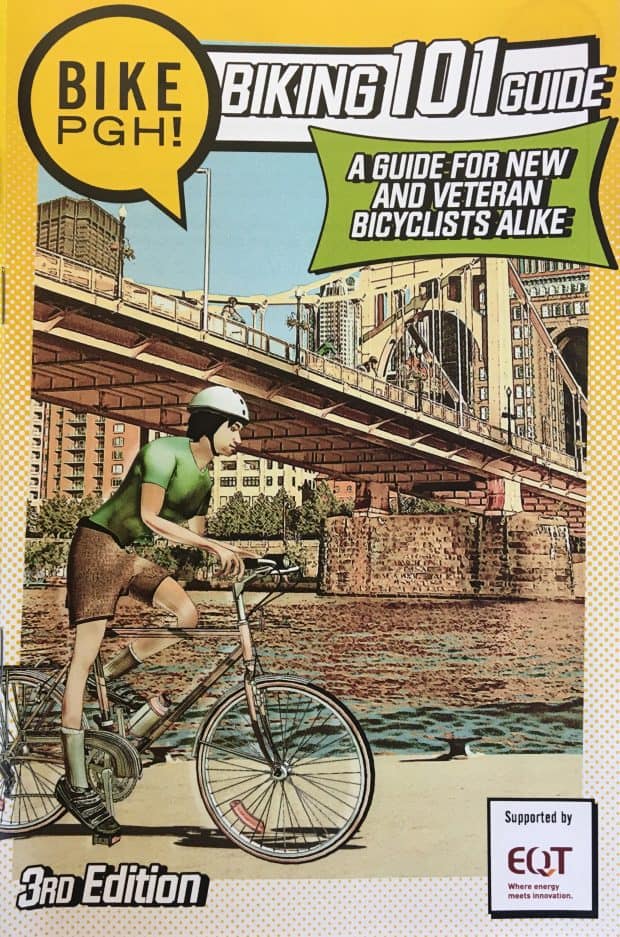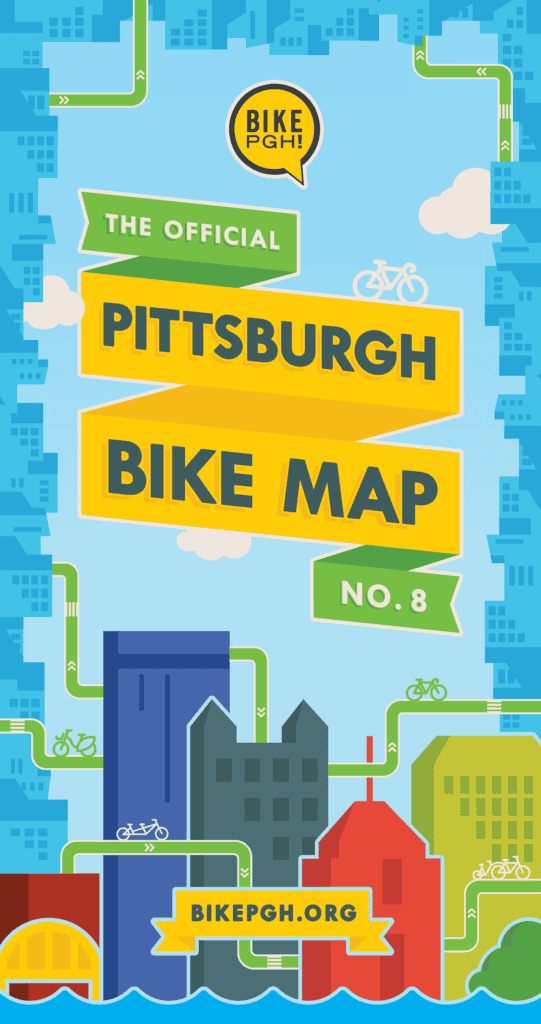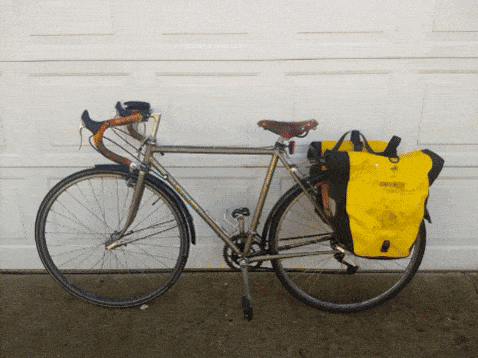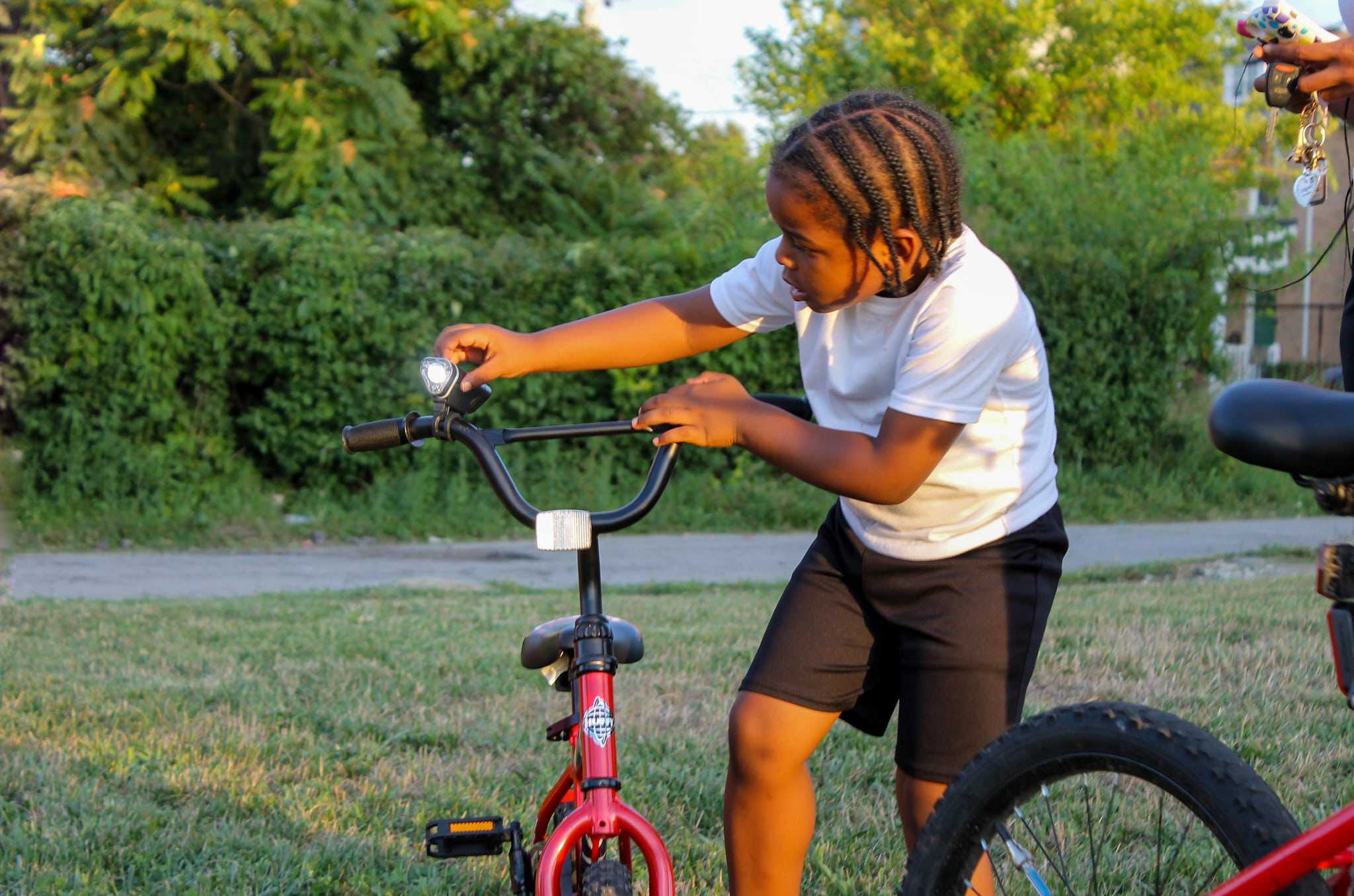
Become A Confident City Cyclist
Just like when you first learned to ride a bike, learning to ride confidently on city streets requires some patience! While we won’t be right there to catch you, we do have a ton of how-to videos, tips, and awesome guides to help you bike your way around the city, and beyond. Start by following these 12 steps!
1. READ THE BIKING 101 GUIDE

Many of our streets have a car-centric design, and that can make it confusing to get around by bike. You may wonder where you’re supposed to position yourself in the road – on the side, in the middle of the lane? You may wonder which vehicle laws apply to you while on your bike. You can learn the answers to these questions and much much more in our free Biking 101 Guide.
Check it out online here or swing by the BikePGH office at 188 43rd Street to pick up a paper copy from the bike stand out front.
2. PLAN YOUR ROUTE

When planning a bike route in Pittsburgh, it’s important to take our hills, rivers, and wonky streets into account. The best route isn’t always the shortest route. Two of the easiest ways to plan your route are by looking at our Pittsburgh Bike Map or using the biking mode on Google Maps.
The Pittsburgh Bike Map shows which routes are safest for bicyclists including bike lanes, neighborways, and trails, as well as which routes you should avoid if possible. Use the digital version, or get a paper copy to carry on your bike or stick it on your wall at home! Paper copies are available outside of the BikePGH office at 188 43rd Street.
Google Maps has a bicycling mode that you can select when looking up directions. When you click to see the details of a route, it will even show you the elevation changes and turn-by-turn street-view images. When browsing an area in Google maps, you can also click the layers button (it looks like two stacked squares) to select “Bicycling” in order to see bike lanes and trails.

3. FIND A BUDDY
Biking can feel lonely if you don’t have a buddy to experience it with. For your first few rides, ask a more experienced friend to ride with you. If you don’t know other cyclists, there are many great ways to connect with the thousands of Pittsburghers who bike. You can check out your local Neighborhood Bicycle & Pedestrian Committee, join in our Women and Non-Binary Program, or reach out through our Message Board.
4. PRACTICE YOUR HAND SIGNALS
Communicating clearly with drivers, pedestrians, and other bicyclists is essential for a safe ride. Hand signals let other road users know when you’re planning to turn or stop. Use strong, confident motions to catch the attention of drivers and leave no question in their minds about where you are going next.

Right Turn: The clearest way to signal a right turn is by fully extending your right arm to the right. If you’re not comfortable removing your right hand from your handlebars, you can also signal with your left arm by making an L shape with a bend in the elbow.

Left Turn: To signal a left turn, extend your left arm to the left. Make sure that drivers can see you from all angles.

Slowing or Stopping: To signal that you are coming to a stop, extend your left arm down, with the palm of your hand facing the car behind you. Release your signal when you come to a complete stop. This is especially helpful when riding with other bicyclists.

5. WEAR WHAT WORKS FOR YOU
Whether you’re commuting to work by bike or taking a speedy ride for exercise, make sure to think about what clothes you’ll feel comfortable riding in, and what clothes you’ll want to be wearing when you reach your destination. Many Pittsburghers who bike don’t wear special biking clothes, but rather everyday clothes that work for biking. Consider the weather conditions, and think about how biking will affect your body, whether you’ll sweat or feel a chill from the wind. For winter-specific clothing tips, check out our What to Wear: Winter Edition blog here.
6. DO AN ABC QUICK CHECK
If it’s been a while since you’ve taken your bike out for a spin, it’s good to do an ABC check on your bike before beginning your ride.
- A is for Air
- Check each tire for proper air by either squeezing the tire to see if it feels firm, or locating the PSI (pounds per square inch) rating on the side of the tire (use a flashlight if you can’t see it) and use a tire gauge to confirm. Need air and don’t have your own pump? Visit a local bike shop or find a bike fix-it station.
- B is for Brakes
- Give a squeeze to each lever by the handlebars while pushing your bike forward. The brakes should stop you from moving your bike forward. You can watch the brake arms hug each wheel (or disc in the case of disc brakes), stopping it when the levers are pulled. If your brakes aren’t functional, find a local bike shop to help you out.
- C is for Chain
- Check on your chain to see if it looks rusty. Lift up your back wheel and run the pedals clockwise with your hand to see if it moves smoothly. If not, you’ll need to apply chain lubricant which you can find at your local bike shop.
After the ABC’s, if you have quick release parts make sure they are securely closed. If you’re not sure if you have quick release, look for a lever on your wheel hubs and seat post. Watch the video above for more information!
7. CONSIDER YOUR LOAD

Depending on where you’re heading on your bike ride, you may need to carry a few things. If you don’t have a rack or a basket, a good old backpack should work for most smaller loads. As you begin to ride more and carry more things on your bike, it’s a good idea to get a comfortable cargo setup. There are lots of options: a rack with a crate, panniers (bike bags), a front basket, a trailer, etc. Read more about how to load down your bike with our blog: How to carry groceries on your bike.
8. TEST IT OUT

If this is your first time riding a new (or new-to-you) bike, or it has been a while, it’s a good idea to do a quick test ride before you head out for a longer journey. Find a quiet street or alleyway where you can do a few laps back and forth.
Think about the geometry of your body on the bike. Are you too stretched out or too scrunched up? Adjust your seat or handlebars if needed (this may require an allen wrench). Are your brakes functioning? Are there any funky sounds that should be checked out? It’s best to get these worries out of the way before you’re too far from home!
9. LIGHT YOUR RIDE

If there’s any chance you’ll be biking at dusk, in the dark, or in the rain, it’s so important to have lights on your bike so that you’re visible to other vehicles. State law says that those biking at night must have a front light and rear and side reflectors. To be extra safe, it’s best to have both front and rear lights and side reflectors. If lights are beyond your budget, stay tuned for our Operation Illumination bike light giveaway events which take place about four times per year.
10. CHECK YOUR HELMET
Take your time, and be patient when fitting your helmet. Follow this step-by-step guide or watch the video above to correctly fit your helmet:
- Loosen the dial on the back of the helmet (if it has a dial).
- Put the helmet on and tighten the dial.
- Make sure the helmet is snug. Shake your head left, right, up, and down.
- Buckle the strap. Make sure only 1-2 fingers can fit between the strap and your chin.
- Check to see if the strap fits around your ears.
- Check to see if your forehead is protected. There should be a maximum of two inches between your brow and the front of the helmet.
Any child under the age of 12 is mandated by law to wear a helmet.

11. RIDE WITH CONFIDENCE
If you’ve done all of the steps above, then you are definitely ready to ride! Here are a few more pieces of advice to help you feel confident while riding.
Take the Lane: One thing about riding a bike in Pittsburgh is that you need to have the confidence to claim a piece of the road for yourself. If you’re riding on a road without bike lanes, and particularly a road with lots of parked cars on the side, it is important to do what we call “taking the lane” or “riding defensively”. Position yourself in the middle of the right lane and stay there, confidently. This prevents cars from trying to squeeze past you dangerously and makes them wait their turn until they can pass you safely with at least four feet of space.
Carry a bus pass: When you carry a bus pass on your bike, you’re giving yourself an out if you need it. If you get a flat tire or don’t have the energy to bike up a long hill, the bus can save you! Watch this video to learn how to put your bike on the bus.
Be predictable: Predictable riders stop at stop signs and traffic lights, give clear hand signals, and make eye contact with other vehicles at intersections.
Know the hierarchy: There is an unfortunate hierarchy on the road. Trucks and buses > cars > bikes > pedestrians. As a bicyclist, you’re in the lower-middle end of that hierarchy. On one hand, this means you need to be aware of the dangers of cars. If a driver is being aggressive, just get out of their way. It’s not worth the fight. On the other hand, this means you need to respect the rights of pedestrians. Yield to pedestrians at intersections. In Yinzer speak, don’t be a jagoff.

12. STICK WITH IT
Sometimes folks give up on biking when they get one flat tire. Don’t let small barriers like this get in the way of continuing your bicycling journey! Many issues that may arise with your bicycle are easily fixable on your own, and there are tons of awesome bike shops around Pittsburgh that can help you out if you can’t solve the issue.
Likewise, you may feel you want to give up after one tough ride. The good news is that riding in Pittsburgh, particularly riding on hills, gets easier every day you do it. Take your time, and try to find low-stress routes with limited elevation changes to build up your confidence.
And, if you just need a little encouragement, you can find plenty through BikePGH’s many resources for this awesome community of people who bike!
1 Comment
Please, Please, Please teach bike riders to announce themselves when passing a walker!! I walk on the Montour Trail and bike riders come flying past me without notice. I have almost been hit twice. I thank those that announce and ask the others to not scare me while flying by, but to no avail.
Thank you